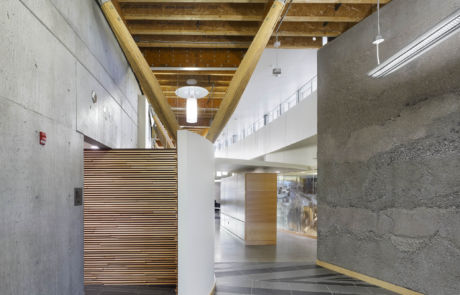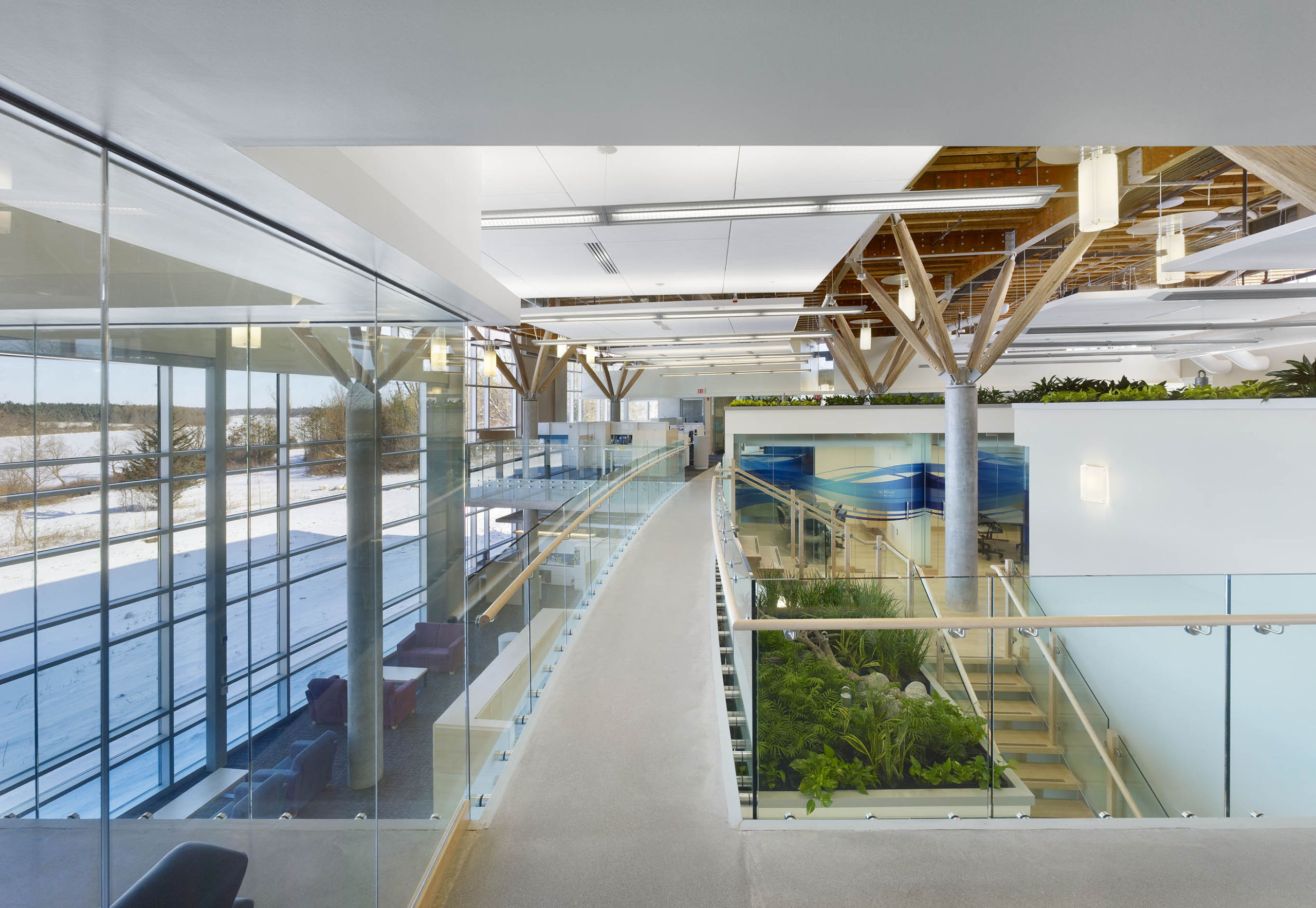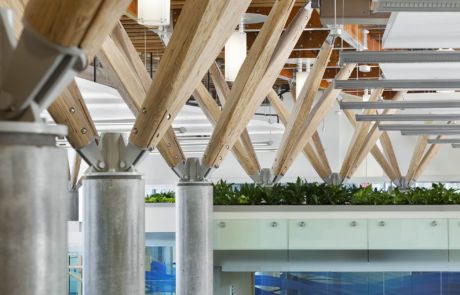- LEED® Features Overview
- LEED® Platinum Certified
- 50+ year life expectancy
- 36,000 square feet
- Construction costs $9.6M ($265 sq/ft)
- Total costs $12.3M (on budget)
- Major construction costs ($3,840,000):
- Concrete – $1,800,000
- Glass – $800,000
- Stone – $500,000
- Structural steel – $320,000
- Flooring – $215,000
- Roofing – $205,000
- Almost 38% of the construction costs are concrete/glass/stone/steel – durable, low maintenance materials – links to the guiding principle of “long term fiscal responsibility”
- Mechanical and electrical systems are reducing energy use by 71% over the minimum requirement for energy efficient buildings as determined by the Model National Energy Code for Buildings. We will recover the premium for the green initiatives within 4-6 years. In time, the energy savings alone could pay for the capital cost of the building.
- Allowance for growth with growth connection
The Energy Efficiency category aims to reduce energy consumption, helping to reduce pollution caused by power generating plants. Energy efficient buildings also have lower operational costs.
The WCC’s exceptional mechanical and electrical systems are reducing energy use by 71% over the minimum requirement for energy efficient buildings, as determined by the Model National Energy Code for Buildings (MNECB). Measures used to achieve this reduction include:
1. Heating, ventilation and air conditioning (HVAC) system:
- The HVAC system is an “air-to-air” heat exchange system utilizing 55 fancoil units (evaporators), 4 branch circuit controllers (gas/liquid separators) and 8 roof top compressors. This system allows for both heating and cooling year round, rather than having to switch from one to the other in spring or fall. The heat pumps can run at partial load (at 10% energy use/capacity if less heat/cooling energy is needed), instead of full-on or full-off like a regular heating system.
- Heat is recovered from zones that are in the cooling mode and transferred to zones that require heating. For example, heat produced by cooling the IT room is transferred to 14 fancoil units and provides a large portion of the heating requirements to the lower east end during the winter.
- Excess heat in the refrigerant tubes (gas) is removed by heat recovery units in the mechanical room and transferred to a heat exchange system that provides all the hot water requirements for the WCC. Any remaining heat is compressed to liquid by the roof top units and returns to the branch circuit controllers.
- A recovery wheel (located in mechanical room) reclaims 60-80% of the conditioned temperatures that would otherwise be lost. In heating season, heat is removed from stale air that is to be exhausted from the building, and transferred to fresh air being drawn into the building. In the cooling season, this process is reversed, removing some heat from the incoming air and transferring it to the outgoing stale air. This system also allows the exchange of moisture to control humidity.
- The temperature of fresh air drawn into the building is moderated with the use of earth tubes and a solar wall, which are passive renewable energy systems. In the summer, two earth tubes take advantage of the earth’s cooler underground temperature. The tubes (50 m long, buried about 2.5 m underground) pre-cool the air by 10°C or more. In the winter, the solar wall (perforated blue panels) on the outer south side of the building absorbs heat from the sun, pre-heating the incoming air by 20°C or more.
- Fresh air is dispersed through high volume, low velocity air diffusers located throughout the building. Dampers in each diffuser adjust the local flow of fresh air in response to CO2 sensors that are installed at every air-handling system and in each zone of the building. These sensors help to save energy during unoccupied periods and provide sufficient ventilation during periods of high occupancy.
- The HVAC system has an automatic temperature setback so it is not heating/ cooling/ ventilating spaces at night or on weekends or holidays.
2. In conventional buildings, one of the greatest sources of wasted energy is from heat loss from a leaky building shell and non-optimal building orientation:
- The building is oriented along the east-west axis, which helps to prevent glare as well as to prevent one side of the building being too warm in the morning and the other side too warm in the afternoon. The north side of the building has the most glazing (glass) to allow for desired solar heat gain and daylight.
- The roof is a white, reflective roof to minimize the urban heat island effect and decrease summer cooling costs for the building.
- The roof has a shaded overhang to prevent glare from direct sunlight through the windows.
- The building shell is air-tight and is constructed from poured concrete with rigid insulation to achieve a high R-value (resistance to air loss) of R40 for the roof and R20 for the walls.
- Windows are triple glazed windows on the north side and double glazed winders on the south side to reduce heat transfer.
3. Lighting is one of the largest energy uses in modern offices:
- The lighting power density (amount of energy used to light a given area) is 15-20% less than a conventional office.
- Light fixtures are high efficiency T8 fixtures.
- Almost all the lighting is on occupancy sensors to only turn on lights when someone is in that area or room.
- Daylighting sensors dim lights when there is sufficient natural light.
- The building’s design and orientation maximizes daylighting so that 75% of spaces have access to daylight.
4. Fanshawe Dam is a flood control dam, but a small hydroelectric generating plant is an ancillary benefit that provides a source of renewable energy for the WCC. The plant produces 2,860 Mwh/year, which is enough to power approximately 300 households. This power was used by multiple buildings including the old admin building, offices on the dam, portables, rowing club building, and a small former residence. The old admin building consumed an estimated 200,000 Kwh/year. Excess generated energy is sold to the grid. When the hydroelectric plant is off line for maintenance, electricity is bought from London Hydro.
The Indoor Environmental Quality performance area employs measures to provide a healthy, comfortable and productive indoor environment for the building occupants.
- An indoor air quality management plan was designed and implemented during construction and before the building was occupied to remove indoor air pollutants created during the construction and minimize contamination of materials. An indoor air quality test was completed prior to occupancy to ensure the air quality was suitable for occupancy.
- All products and materials used in the WCC are low-emitting/low off-gassing to help protect the indoor air quality.
- Fresh air is dispersed through high volume, low velocity air diffusers located throughout the building. Dampers in each diffuser adjust the local flow of fresh air in response to CO2 sensors that are installed at every air-handling system and in each zone of the building. These sensors provide sufficient ventilation during periods of high occupancy and help to save energy during unoccupied periods.
- Some windows can be manually opened and there are additional thermostats throughout the building, allowing employees comfort control over their work environment.
- Fresh air produced by plants on top of the stacked meeting rooms circulates throughout the building.
- The building’s design and orientation maximizes daylighting so that 75% of spaces have access to daylight. The layout of the workstations and offices provide views to the outdoors for 90% of the spaces. Interior shades can be mechanically lowered if desired.
Innovation in Design credits are achieved for exceptional performance above the requirements set by the rating system.
1. A green education tour with signage and brochures has been implemented to provide information to the public about the WCC’s sustainable features.
2. Low-flow plumbing fixtures have reduced overall water use by 40%. 100% of the water used for sewage conveyance is non-potable water supplied by groundwater captured and stored in a cistern.
3. A green housekeeping program has been implemented using Green Seal certified cleaning products and high recycled content disposable materials. Green Seal is an independent non-profit organization dedicated to safeguarding the environment and transforming the marketplace by promoting the manufacture, purchase and use of environmentally responsible products and services. The Green Seal Certification ensures that a product meets rigorous, science-based leadership standards. This gives manufacturers the assurance to back up their claims and consumers confidence that certified products are better for human health and the environment.
4. A LEED accredited professional was a principle participant of the WCC building team, providing support and guidance throughout the LEED design, construction and certification process.
The Materials & Resource Selection category looks to strategies that efficiently use and dispose of building materials in ways that lessen negative impacts on the environment.
1. During construction 90% of all construction waste generated was diverted from landfill.
2. Nearly 20% of the building materials contain recycled content:
• Concrete contains a minimum of 25% recycled content
• Asphalt contains a minimum of 25% recycled content
• Steel contains a minimum of 40-50% recycled content
• Interior wall systems contain a minimum 45% recycled content
3. 27% of the building materials (including concrete, wood and glass) were extracted and manufactured locally (within 800 km of the project site), which means less transportation energy was used to bring these materials to the construction site.
4. 81% of all wood-based materials are FSC-certified (Forest Stewardship Council). The FSC certification ensures wood products come from responsibly managed forests that are evaluated to meet FSC’s strict environmental and social standards. Using FSC certified products protect forests from exploitation through unsustainable forestry and manufacturing practices.
5. The HVAC system does not contain hydrochlorofluorocarbons (HCFCs). HCFCs are being phased out in developing countries because they are ozone-depleting compounds.
The Sustainable Sites category strives to balance the needs of people and the needs of the environment in a way that benefits both. Protecting/restoring the natural landscape, encouraging the use of alternative transportation and management of stormwater are a few of the actions that can be taken to make a sustainable site.
1. A transportation management plan encourages staff to use alternative transportation into work, reducing the negative impact of automobile use. The plan includes:
a. Indoor bicycle storage room and change rooms with showers.
b. Designated prime parking spots for high-efficiency vehicles (use 6 L or less per 100 km) and carpooling, and three electric car plug-in parking spots.
c. Multiple hybrid vehicles in the UTRCA fleet.
2. The site has been developed with a focus on restoring a minimum of 50% of the site area as natural habitat to promote biodiversity and provide open space for building occupants. The landscaping is comprised of native and adaptive species that do not require irrigation, saving water and minimizing maintenance.
3. The garden area along the WCC entrance is the roof of the underground storage room (bunker). This green roof is planted with sedums and other low-maintenance plants that tolerate dry conditions. The green roof, along with trees planted in and around the parking lot, help to cool the local microclimate in the summer, creating a more comfortable outdoor environment for employees and wildlife. The WCC has a white, reflective roof to minimize the urban heat island effect.
4. The stormwater management system includes a gravel parking lot (near the main road), swale and pond. This system is one of the best designs in low impact development (LID) for green infrastructure. By eliminating the need for a storm sewer on site, we’ve reduced the overall cost and are improving the quality of runoff water. Grass swales and wetland vegetation help to stop erosion, and remove suspended sediments and pollution from stormwater that flows overland into the pond. The pond retains and cleans stormwater on site. Reducing the speed and volume of stormwater and improving stormwater quality helps to protect downstream waterways.
5. The exterior lighting on the building and in the parking lot is designed to protect the nocturnal environment ensuring that the light fixtures are full cut-off( lighting is not emitted above 90 degrees) as well as reducing the exterior lighting power density by 25% compared to the ASHRAE baseline.
The Water Efficiency category awards credits for strategies that minimize negative impacts to the environment and lessen the burden and demand on local water supplies and municipal water and wastewater treatment facilities. Reducing water usage also reduces operational expenses.
1. Indoor potable water use has been reduced by 76% compared to the conventional baseline use, through the following strategies:
- Installing low flow plumbing fixtures
- Groundwater from a shallow aquifer is collected in a building tile around the perimeter of the building, carried to a cistern and stored for non-potable usage. Filter cloth around the pipe helps to remove suspended sediments from the water. 100% of the water used to flush the toilets and urinals is from the cistern, completely eliminating the use of potable water for sewage conveyance. Water stored in the cistern is also used for outdoor irrigation, which will be minimal once the native plants become established. (Water from the roof is not used within the building because it would require treatment; instead, it is piped to the ground and outlets near the SWM pond.)
- Plants on the indoor green roofs are watered by drip irrigation, which uses less water than conventional watering methods.
- The landscaping around this building is comprised of native and adaptive species that do not require irrigation, saving water and minimizing maintenance.
2. The WCC is not connected to the municipal sewer system. All wastewater produced within the WCC is treated on-site by a septic tank and a tertiary system known as the Waterloo Biofilter, which uses bacteria to degrade, oxidize and consume contaminants found in the water.
Wastewater is first treated within the two chamber, 30,000 L septic tank (capacity of 15,330 L/day). In the septic tank, anaerobic bacteria/ microorganisms break down the wastewater/ effluent. The tank is designed so that heavier particles settle to the bottom and lighter particles float on the top. As the clearer effluent leaves the septic tank, it is further screened by an effluent filter to prevent solids from leaving the tank.
Effluent moves from the septic tank into a single compartment, 20,450 L pump chamber, where it is stored before being sprayed over the Waterloo Biolfilter treatment systems. This system consists of two above grade, open bottom biofilter treatment units (cedar sheds). A force main (pressurized pipe) carries effluent from the pump chamber to the sheds, where the effluent is sprayed evenly over a filter medium (foam biofilter cubes). As the effluent trickles over the absorbent biological medium, beneficial microbes consume organic pollutants, coliform bacteria, ammonium and contaminants present in the septic tank.
During the third and final treatment, the treated water is released back into an underlying Waterloo Biofilter area bed, which consists of a layer of stone over top of a layer of sand. The treated water is cleaner than that produced in a standard septic system, and there is no tile or perforated pipe which is typical in standard filter or leaching bed systems.
- The Watershed Conservation Centre has achieved LEED® platinum certification.
- LEED® (Leadership in Energy and Environmental Design®) is North America’s premier green building rating system. Administered by the Canada Green Building Council, this third-party rating system awards points to buildings according to the sustainable features they incorporate in six categories:
- Sustainable sites
- Water efficiency
- Energy and atmosphere
- Materials and resources
- Indoor environmental quality
- Innovation in design, which rewards projects that exemplify sustainable strategies and building practices that are not fully embodied in existing LEED® credit requirements
- Credits and prerequisites are organized into the above categories, with the level of LEED® certification based on the total point score achieved in these areas.
- The four levels of LEED® certification are Certified, Silver, Gold and Platinum.
- Location in Fanshawe CA The UTRCA Building Committee spent considerable effort in selecting the site for the WCC. The Committee developed a weighted site evaluation matrix that included 11 criteria such as: available room for future growth, proximity to public transportation, low energy site features, natural heritage features, and access to recreational opportunities such as trails. Ten potential sites were identified and the site receiving the highest overall ranking was the location of the original administration office.
- Meeting Rooms Having multiple meeting rooms was identified as a high priority in the needs assessment. The WCC has 11 meeting rooms in total – the boardroom and 2 large rooms adjacent to it, plus 8 stacked rooms (including 3 that can be combined). Some of the meeting rooms have monitors and conference call capabilities. The boardroom is available for use by non-profit partners, municipalities, agencies. Sliding wall partitions can limit access to the rest of the building.
- Storage Bunker The bunker replaces expensive offsite storage of files that we are required to keep, so we no longer have those annual fees ($13,000/year). Files are in the process of being returned to us now. Phase 1 of the project was construction of the new facility. Phase 2 included moving into WCC, demolishing the old office, and building the storage bunker in the footprint of the old office. Above the bunker is the green roof and front entrance.
- Recycling Centres The internal Trash Talkers team worked with environmental studies students from UWO to develop a plan for waste disposal, recycling and composting. We have two recycling centres where staff sort their waste, recycling and compost.
- Wet Lab The wet lab is used by our biologists. We had a long-standing relationship with a professor at UWO and we were able to use their lab space for free. When that professor left, we lost our use of the lab so this room became a need. The lab is used by staff for such tasks as analyzing benthic samples and incubating turtle eggs.
- Quiet Room The quiet room also functions as a First Aid room and prayer room.
- Flood Control Room Key areas such as the flood control room are on a back up generator in the event of a power failure.
- Wellness Room The wellness room is used for staff training that otherwise we would have to pay for – we rented space off site for use of force and first aid training. As an organization we really support wellness as a lifestyle with a staff wellness team. We have a very low use of prescription drugs, which keeps our premiums low. The wellness room is also used by staff for rehabilitation and physiotherapy.
- Growth Space & Growth Connection The unoccupied areas are part of the building’s 25% growth space. When we toured other new facilities, we found they consistently underestimated the need for office space and were already making changes or planning additions. If we ever need to expand, the building is designed with a growth connection on the east end.
- Sound Masking, Clouds A sound masking system and ceiling “clouds” help to mute noises and reduce distractions.

LEED® Platinum Certified
LEED® (Leadership in Energy and Environmental Design) is North America’s premier green building rating system. Administered by the Canada Green Building Council, this third-party rating system awards points to buildings according to the sustainable features they incorporate in six categories.

Rent the Facility for an Event

Where We Are
The Watershed Conservation Centre is located at 1424 Clarke Road, London, Ontario N5V 5B9











